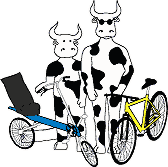Tech Tips from The Bike Barn
We like to provide useful information to riders, whether it's about riding in winter, avoiding cross-chaining, taking care of your tires, or one of our older topics. If you have questions that you don't see answered here, come and visit us or send questions to [email protected].
Winter Riding
What you wear
When riding in the winter, what you wear is more important than what you ride. Layer your clothing and start out underdressed so you don't overheat. It is a good idea to take along something warmer in case you stop outside for any extended time period (such as for mechanical difficulty.)
The 3 areas that could freeze most easily are your face, your hands, and your feet.
- Protect your face with a parka-type hood (which may somewhat limit your peripheral vision,) and/or a ski mask, and/or goggles, hat and scarf.
- For your hands, insulated mittens, possibly over thin gloves, work the best for below 20 degrees, insulated gloves are ok for 20-40 degrees and any full glove for above 40.
- Keep your feet warm with snow boots or tennis-shoe-style hiking boots large enough to go over a thick pair of wool socks. Remember that if you have too many layers of socks and your shoes are too tight, your feet loose circulation and freeze anyway.
What you ride
Ride a well-serviced, moderate- to wide-tired bike, depending on road surfaces. Lower tire pressures (35-40 psi) work better than higher pressure to give you more traction. Glare ice is nearly impossible to ride on with any bike, but studded tires make it easier than walking.
Where you ride
It can be a challenge to find a suitable place to ride in the winter. If you are commuting, use the streets or trails that are in the best condition. If you want to ride recreationally, paths that snowmobiles have used are pretty bumpy, and paths that cross-country skiers have somewhat packed down are somewhat better.
Cross Chaining
We are repeating this tech tip because so many bikes that come in for repair or in from a test ride are cross chained. Cross chaining occurs when the gears are used that place the chain on the inside sprocket (1) in the front and the outside sprocket (7) in the back or on the outside (3) in front and the inside (1) in back. This puts the chain at an extreme angle which causes excessive chain and sprocket wear and also causes less than the smoothest shifting. While these 2 extreme angle gears are legitimate and certainly may be used, there are other gears that duplicate or come close to duplicating these gears. Recommendation: Unless you are "just passing through" as in preparing for a steep hill or recovering from a steep climb, stay away from the 1-7 and the 3-1 combinations of gears.
Tire Care
Bicycle tires have tubes and should be kept inflated to the pressure recommended on the tire sidewall. Under-inflation causes creep of the the tube within the tire and can be visually identified by crooked valve stems. Riding with under-inflated tires could tear the valve stem out of the tube and necessitate replacing the tube.
Over-inflation usually leads to blowouts either during inflation or at some later time. Blowouts could result in bending the rim, possibly beyond repair.
The second quickest way to ruin a tire is probably skidding. Tires aren't very thick and one major skid could wear through the surface of the tire.

